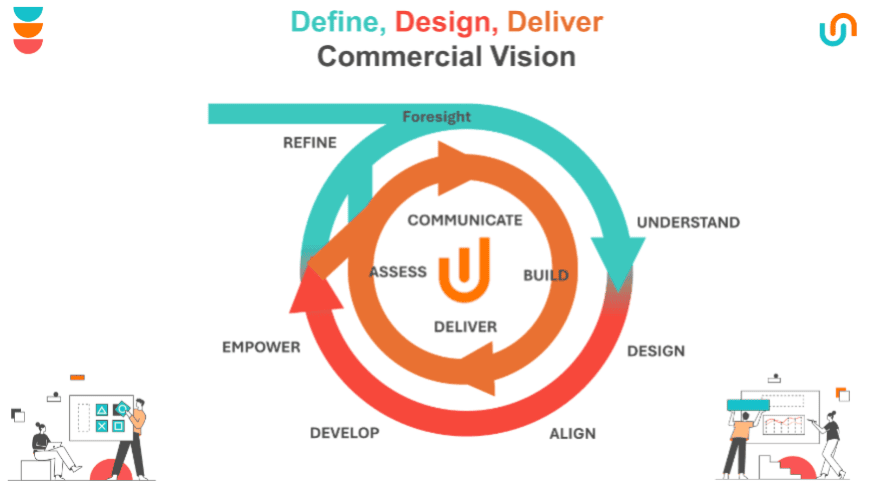
How to define, design and deliver your commercial vision
Every successful organisation thrives on a clear and compelling vision. A well-defined vision sets the stage for growth, guiding both leadership and teams as they navigate the complexities of the business landscape. This webinar , the first in our Build Your Commercial Leadership webinar series explores essential strategies for designing and executing a vision that aligns with both internal values and market conditions.
The Vortex model
One effective framework for building a vision is the 'vortex model,' which emphasises balancing two critical loops: the 'thinking loop' and the 'doing loop.' Leaders must simultaneously cultivate foresight and adaptability, ensuring their vision can evolve to meet future challenges. The importance of alignment between vision, mission, and strategy cannot be overstated—successful companies know how to integrate these elements to create a powerful growth trajectory.

Aligning Value Propositions with Customer Expectations
At the heart of any successful business lies its value proposition—the promise it makes to its customers. For long-term success, companies need to ensure that their value proposition is not only understood internally but also aligns seamlessly with customer expectations. A feedback loop is crucial here, allowing companies to assess whether their impact matches their intention.
In today's rapidly changing market, leaders face the constant challenge of aligning diverse opinions and ideas. By encouraging collaboration among leaders with varied expertise, organisations can sharpen their strategies and better address customer needs. Leading with expertise—whether in product development or services—also ensures that businesses remain competitive and focused on delivering excellence.
Focusing on Core Strengths and Market Alignment
Businesses that stay true to their core strengths are better equipped to align with market demands. A strategic approach to this alignment involves three key steps. First, companies can co-create small ideas with key partners who understand the industry deeply. Second, expanding collaboration to a cross-functional team helps refine these ideas and ensures broader buy-in. Finally, rolling out the plan with a well-executed launch creates excitement and establishes a clear direction.
Consistent communication is another critical factor for maintaining alignment. Businesses should celebrate milestones to maintain momentum and keep teams motivated. Healthy friction, where teams challenge themselves and each other, also plays an essential role in pushing boundaries and fostering innovation.
Adapting to Market Conditions: Flexibility is Key
In a constantly shifting market, flexibility is a must. Organizations must be able to adapt their strategies based on new information and changing circumstances. A vision is not a static document—it should evolve alongside the company’s growth and the market’s demands. Leaders who remain open to different opinions and who welcome adaptability will ensure their vision stays relevant.
For example, companies that can pivot quickly to respond to new trends often outperform their competitors. Whether it’s adapting product lines or reevaluating customer needs, staying flexible is essential to maintaining a competitive edge.
Aligning Personal and Commercial Goals with the Company’s Mission
An organisation's mission should resonate not only in its business operations but also in the personal goals of its leaders and employees. Aligning personal and commercial visions with the company’s overarching mission ensures that every decision made contributes to the larger goal.
This alignment becomes especially important when external challenges arise. For instance, leaders often face pressure to reduce prices or shift focus, which can conflict with long-term objectives. In such cases, leaders must ask whether these actions align with the company's mission and vision for the future. Clear communication is the foundation for alignment across all levels of an organisation. A compelling narrative that reflects the company's values and goals helps inspire both internal teams and external stakeholders. Regularly sharing this story across all functions fosters a shared sense of purpose and direction
For those interested in diving deeper into these strategies and seeing real-world examples, the webinar is available is to watch here.